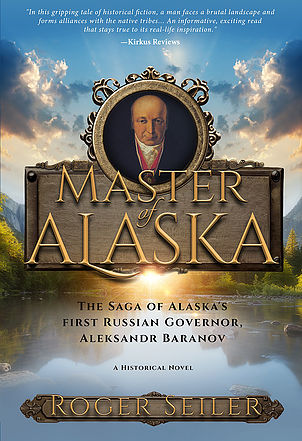A new book called Master of Alaska portrays a side of Aleksandr Baranov that other historical writings have not considered.
Roger Seiler wrote a novel based on meticulous research of Baranov’s letters and other material. Seiler grew up in King Salmon and was long fascinated by Barnov’s story. Seiler said Baranov was a critical figure in Alaska’s early history.
 SEILER: He was eventually able to bring about peace with the Tlingits in Southeast Alaska. That’s after having undergone a real war with the Tlingits. But he was able to make peace with them, with his main antagonist throughout his career, Chief Katlian. The picture in the back of the book which shows Chief Katlian and his wife, in that picture, Chief Katlian is wearing the Allies of Russia Silver Medal around his neck that Baranov awarded to him after they were able to make peace.
SEILER: He was eventually able to bring about peace with the Tlingits in Southeast Alaska. That’s after having undergone a real war with the Tlingits. But he was able to make peace with them, with his main antagonist throughout his career, Chief Katlian. The picture in the back of the book which shows Chief Katlian and his wife, in that picture, Chief Katlian is wearing the Allies of Russia Silver Medal around his neck that Baranov awarded to him after they were able to make peace.
TOWNSEND: Why did you decide to write it as historical fiction rather than just chronicling his life and adventures in Alaska?
SEILER: Well the thing is that there’s a lot of drama in the story of Baranov. However, history doesn’t happen in a natural three act structure which is sort of what you need to make it work as a dramatic story. And so you have to do some reordering of events to make it really work as a story. And also, in order to bring out the characters, you need dialogue and once you start putting dialogue in their mouths, even if it’s based on what we know about those characters, and based pretty closely on that, then it becomes fiction.
TOWNSEND: In your book, you write that if it were not for Baranov, Alaska would likely be part of Canada. Why is that?
SEILER: Well the thing is that the British wanted to take Alaska away from the Russians and add it to Canada. And the Russians, until Baranov got there, there was just chaos and he was able to get things organized, hold Alaska together as a colony, and thus have it to sell to the United States when the U.S. became interested in it in 1867.
TOWNSEND: Tell us about the Native women that are in your story. Three of them play prominent roles. Tell us about how you developed these characters and who they’re based on.
SEILER: Most of the source material that I relied on consisted of letters that Baranov wrote back to Russia and letters that other people wrote that talked about him and so on. He always made a copy of every report and letter that he sent back to Russia because a third of the ships sank on the way so he always wanted to have a coy ready so he could prove that he actually did send an earlier report. We got those letters when we bought Alaska from Russia. In those letters, he describes Anna a couple times, not in any great extent, but enough that it gave me an idea of the role that she played in his life and the influence she could very well have had on him, especially regarding his gift of empathy, cause she was a very empathetic person. The wife of Chief Katlian, the only thing we know about her is what we see in that picture in the back of the book in the appendix. She is quite a striking figure in that picture. She’s obviously very satisfied with her situation, whereas he isn’t quite satisfied. He has a very stern expression on his face even though he’s made peace with Baranov, but she’s quite satisfied with the way things have worked out. As far as Baranov’s daughter, she was written about in letters that her husband, who succeeded Baranov as Governor, wrote about his wife. She married a Russian naval officer and then he was appointed Governor after Baranov.
Lori Townsend is the news director and senior host for Alaska Public Media. You can send her news tips and program ideas for Talk of Alaska and Alaska Insight at ltownsend@alaskapublic.org or call 907-550-8452.





